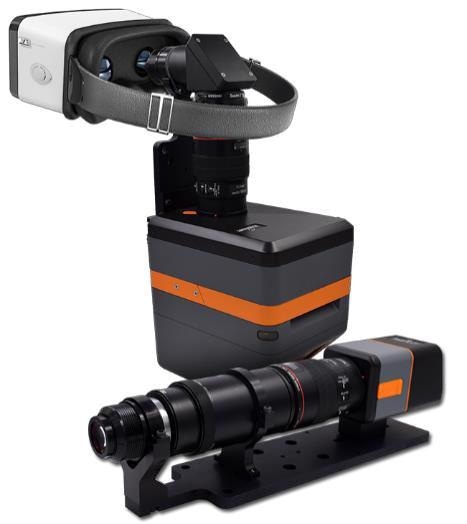Radiant Vision Systems, a leading provider of visual test and measurement solutions for light sources and displays, announces the release of its new XRE Lens for near-eye display testing of extended reality (XR) headsets and smart glasses.

Image Credit: Radiant Vision Systems
Utilizing patent-pending technology that features electronic focus and configuration options, the XRE Lens offers flexibility for evaluating visual elements as they are seen through the headset, simplifying the task of deploying measurement for a diverse array of AR, VR, and MR devices. The lens pairs with high-resolution ProMetric® imaging colorimeters and photometers and TT-ARVR™ Software to provide a complete automated visual inspection solution for XR display testing in R&D and production.
In 2018, Radiant transformed XR display testing with the release of its award-winning AR/VR Lens—the first commercially available imaging metrology solution to feature a lens design with optical entrance pupil (aperture) at the front. This design allows the test system to be positioned within a headset to replicate the near-eye pupil position of the human eye. Applying wide-field-of-view (WFOV) optics, the AR/VR Lens solution is able to image the entire immersive display field of view (FOV) to evaluate all visual qualities as viewed from the user’s perspective.
“Fundamentally, replicating the human visual experience has continued to drive the optical design of XR test systems,” states Eric Eisenberg, Optics Development Manager at Radiant. “But the diversity of XR devices and their measurement requirements continue to expand. New display types, FOVs, resolutions, focal distances, form factors, and unique combinations of these elements can’t be addressed universally with a single optical solution. Many manufacturers opt for custom measurement/optical solutions, which carry a significant time and cost burden, and which are not easy to deploy. With the release of Radiant’s new XRE Lens, we can begin to address the diversity in XR optical designs and reduce the need for costly custom measurement equipment design cycles. The XRE Lens solution provides manufacturers with several specification options and flexible features to meet unique measurement parameters.”
The XRE Lens is the first imaging metrology solution to offer electronic focus for in-headset XR display testing. Electronic focus allows precise focal distances to be set and adjusted remotely via software to measure multiple or variable focal planes. Electronic focus also enables automated focus changes as part of fully automated visual inspection routines, optimizing testing efficiency and supporting advanced analysis.
“Electronic focus is a huge advantage for XR testing,” states Eisenberg. “Analyses like through-focus MTF [modulation transfer function] are simply impossible with traditional manual lenses. This analysis requires the system to iterate through a series of focus distances to find best focus for multiple regions across a display. A complete analysis could require thirty or more focus adjustments. Using a manual lens, these settings are imprecise and time-consuming—potentially taking hours for a complete analysis with little confidence is the accuracy of the result. With electronic focus, a through-focus MTF analysis can be fully automated to provide results in a matter of seconds.”
To provide additional flexibility, the XRE Lens is available in two configurations—folded or non-folded—to achieve the appropriate near-eye measurement position within different headset form factors. The folded (“periscope”) geometry can be applied to measure devices with head straps or other headgear that prevent a linear path to the near-eye measurement position. A folded configuration also supports dual-eye (stereoscopic) measurement, where two XRE Lens systems are positioned inside the headset at once to capture simultaneous measurements of left- and right-eye positions. Both folded and non-folded lens configurations pair with either the ProMetric Y Imaging Photometer for luminance-only measurement or the ProMetric I Imaging Colorimeter for measuring values of luminance and chromaticity. Manufacturers can choose from 29-, 45-, and 61-megapixel resolution options to maximize imaging precision over the solution’s ±35° (70° total) field of view.
A live product demonstration of the XRE Lens will be available at Radiant’s booth (#1307) at the upcoming live Display Week exhibit, May 10-12 at the San Jose McEnery Convention Center. Prospective attendees are invited to apply Radiant’s guest code 8KstwXvP for complimentary registration to the exhibit.